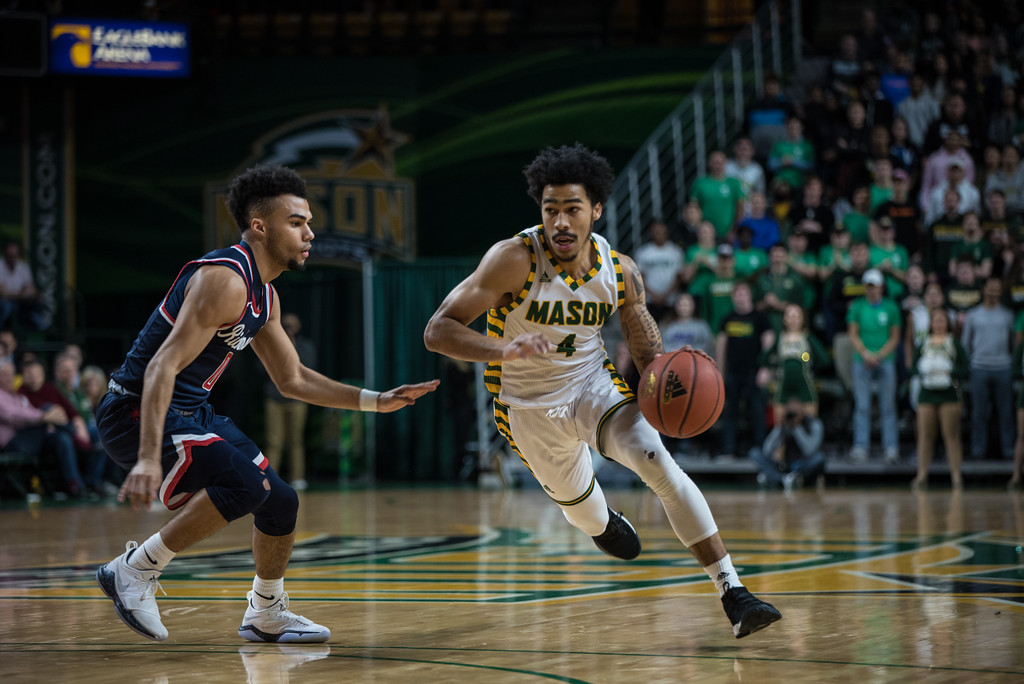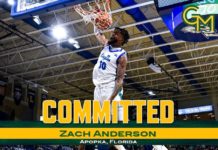Welcome! Here’s my meticulously researched, somewhat arbitrary take on where the A10 basketball all-conference recognition should shake out. This will all be obsolete soon when the actual teams are announced, and I wouldn’t have it any other way. If you’re curious to track how the race has evolved over the season you can check out the Player of the Year watch column that had three installments over the season.
If you’re into nerding out on A10 basketball, follow me on twitter @peteybuckets. Some notes on methodology:
- Numbers listed are for the season, not conference only.
- The criteria for rankings is mostly in my head, but I’ll heavily favor a combination of efficiency, workload, and defensive production. I reserve the right to be completely arbitrary about how good a defender I think someone is.
- If you’re not a big dork like I am, here’s a quick primer on the numbers we’re using. If you’re familiar with this stuff continue reading:
- PER: Short for Player Efficiency Rating, this adds up positive contributions like points, rebounds, steals, blocks, etc, subtracts negative contributions like turnovers and missed shots, and spits out an efficiency rating. Efficiency is important for guys who put up impressive raw stats.
- USG: Usage rate, or how many possessions a player “uses” while he is on the floor. Used in this context means took a shot, went to the foul line, or turned the ball over. This helps us gauge a player’s workload.
- TS%: True shooting percentage bakes in three-pointers and foul shots, so it’s weighted to be more meaningful than regular field goal percentage. This is the best way to look at scoring efficiency.
Here are the awards. We’ll go through the individual superlatives, specialized teams (all-rookie, all-defense) then get to all-conference teams afterward. A quick note before we start – this is one of the most unusual years I can remember. The all-conference first and second teams usually recognize players who contributed to winning teams, but some of the strongest candidates are on bottom half teams this year. We’ll get to it later, but there is not much separation whatsoever between the fifth spot on the first team and the first couple spots on the third team.
As usual, thanks to College Basketball Reference, hoop-math, and kenpom for the data. Here we go.
Player of the Year
Jaylen Adams, St. Bonaventure
20.5 points, 3.6 rebounds, 5.3 assists, 1.6 steals
24.0 PER, 25.9 USG%, .645 TS%
Jaylen is 11th in the country in three-point percentage at 47.7% and he also sports a top 100 assist rate. This was looking like Jared Terrell’s award for a while, but Jaylen Adams is arguably more important to his team and sports better numbers across the board.
Most Improved Player
Luwane Pipkins, UMass
21.1 points, 3.5 rebounds, 4.1 assists, 1.5 steals
21.0 PER, 33.4% USG, .557 TS%
I was skeptical on Pipkins coming into this season because he was an inefficient volume scorer last year with 10 points per game on 10 shots per game. This season his TS% has jumped to .557% from .471%, his assist rate went from 16.3% to 26.7%, and that happened while the talent around him suffered a tremendous drop-off, as UMass is relying heavily on walk-ons because they need warm bodies. Darrell Davis and Cyril Langevine might win in other years, but Pipkins wins this one going away.
Sixth Man of the Year
Cyril Langevine, Rhode Island
6.2 points, 6 rebounds, 1.2 blocks
20.8 PER, 16.3% USG, .621 TS%
I’ve seen some people give this award to Courtney Stockard, but I don’t see how he can count. He started 13 of 18 conference games. If there’s definitive criteria that allows him in, he should win it, but until I see such criteria I’m giving it to Langevine. Bringing Langevine off the bench gives Rhode Island a transformative dimension because he’s such an athletic freak in the paint, and he hit his stride toward the end of the conference schedule.
Coach of the Year
Danny Hurley, Rhode Island
Despite the slow finish, Hurley’s team still won the conference outright with two games to spare and has them in position to do damage in March. If you want to punish Hurley for hitting a speedbump you could give this award to Mark Schmidt of St. Bonaventure, but I don’t think that’s the right move. Dave Paulsen of George Mason also merits consideration.
Defensive Player of the Year
Stanford Robinson, Rhode Island
9.6 points, 5.6 rebounds, 1.8 assists, 2.3 steals, 0.5 blocks
1.9 Defensive Win Shares, 6.4 Defensive Box Plus/Minus
This could also go to Yuta Watanabe, but Stan the Man is the most important defender on the conference’s best defensive team. Rhode Island plays with only one true big almost exclusively, which leaves Robinson guarding much bigger players. His ability to effortlessly switch from guarding the perimeter to guarding the post gives Rhode Island a ton of flexibility. The numbers back up the eye test, as Robinson leads Rhode Island in just about every advanced defensive metric you can find.
All-Defensive Team
Yuta Watanabe, George Washington
Hasahn French, Saint Louis
Ladarien Griffin, Saint Bonaventure
Joseph Chartouny, Fordham
Rookie of the Year
Kellan Grady, Davidson
17.9 points, 3.3 rebounds, 1.9 assists, 0.8 steals
21.0 PER, 24.7% USG, .611 TS%
Grady pulled away from the field over the back half of conference play, posting games of 28, 30, 39, and 16 points to end the season. Davidson gets over 52 of their 76.8 points per game from Peyton Aldridge, Grady, and Jon Axel Gudmundsson, so Grady’s emergence has been instrumental to Davidson’s third-place finish.
All-Rookie Team
Grant Golden, Richmond
Eric Williams Jr., Duquesne
Hasahn French, St. Louis
Jacob Gilyard, Richmond
All-Conference First Team
Jaylen Adams, St. Bonaventure (Player of the Year)
Jared Terrell, Rhode Island
17.8 points, 3.3 rebounds, 2.4 assists, 1.6 steals
21.6 PER, 26.0% USG, .581 TS%
Jared Terrell would have won Player of the Year going away if Rhode Island swept through the conference and won it by three or more games. He still might win it as the best player on the conference’s best team. He’s a big part of Rhode Island’s superlative perimeter defense (top ten in the NCAA in turnover percentage and opponent 3-point rate) and if he’s not the Player of the Year, he’s easily on the first team.
Peyton Aldridge, Davidson
21.3 points, 7.8 rebounds, 2.4 assists, 0.6 blocks
25.3 PER, 28.4% USG, .587 TS%
I think this is the last guy with a shot at the POY crown. Two weeks ago I had it 35% Terrell, 35% Adams, 20% Justin Tillman, and 10% Aldridge. I think the separation of the top three teams is too obvious and all three of the top teams have worthy candidates, so Tillman is out (through no fault of his own). I think it’s extremely close and Adams, Terrell, and Aldridge will all get votes. Today I’d handicap it at 35% Adams, 35% Terrell, and 30% Aldridge. It’s as tight as it can get.
Justin Tillman, VCU
18.9 points, 9.7 rebounds, 1 block
27.3 PER, 27.8% USG, .606 TS%
Fair or not, I don’t see how Justin Tillman can get Player of the Year consideration when there are three worthy candidates on much better teams. Tillman’s a beast either way and should be recognized with all-conference first team accolades.
Yuta Watanabe, George Washington
16.6 points, 6.3 rebounds, 1.6 assists, 0.8 steals, 1.6 blocks
20.0 PER, 24.0% USG, .540 TS%
I’ve got Yuta here because he’s a defensive powerhouse and GW doesn’t have a ton of talent around him. GW is second in the A10 in block rate and seventh in steal rate with Yuta contributing heavily in both categories. He’s been more of a scorer for GW than is ideal, but he’s been carrying it well. Though they couldn’t avoid the play-in game, GW is 5-3 in their last eight heading into the tournament.
Second Team
Second team is a damn mess. A few of these guys could be the fifth man on the first team and a few of them might not make any team. Just like in the A10 standings, there’s not a ton of separation in the middle.
Josh Cunningham, Dayton
15.5 points, 8.3 rebounds, 1.8 assists, 0.5 steals
24.8 PER, 23.5% USG, .674 TS%
Cunningham is a strange case because while he’s clearly an elite player, he’s just not relied on as much as other guys on this list. I had him on the first team up until an hour before I hit publish, when I realized his efficiency numbers are so good simply because he’s not used as much as he should be. Can’t have a guy like that on the first team when his calling card is his ability to score.
BJ Johnson, La Salle
20.9 points, 8.5 rebounds, 0.7 assists, 1.3 steals, 0.7 blocks
23.4 PER, 30.8% USG, .557 TS%
Classic case of a stud on a bad team. I could see him landing here in the fifth spot of the A10’s first team or I could see him being third team. There’s very little separation between the next seven or eight guys.
Otis Livingston, George Mason
17.5 points, 3.4 rebounds, 4.5 assists, 1 steal
19.0 PER, 25.2% USG, .567 TS%
All of Otis’s numbers in these categories are significantly better in conference play, which needs to count for something. He’s got two more points per game, more assists, more steals, more usage, and he’s much more efficient. He was the driving factor in dragging a young, overmatched, and undersized Mason team to a five seed.
Matt Mobley, St. Bonaventure
18.2 points, 5.1 rebounds, 2.5 assists, 1.2 steals
18.6 PER, 23.7% USG, .590 TS%
Second team feels right for Mobley. He’s another guy who could legitimately grab that fifth spot on the first team, but he’s had his share of stinkers this year.
Shavar Newkirk, St. Joseph’s
17.6 points, 4.3 rebounds, 3.8 assists, 1.5 steals
20.0 PER, 27.3% USG, .516 TS%
Newkirk is a strange case. Coming back from ACL surgery last year, he played below his standards for much of the season and had some woofers early on in conference play. He’s turned it on lately and is a big part of the reason no one wants to face the Hawks in the A10 tournament.
Third Team
Kellan Grady, Davidson (Rookie of the Year)
Luwane Pipkins, UMass (Most Improved Player)
This might be controversial but I can’t find the last time a player on a bottom-two team has made any all-conference team. Pipkins is one of the best players in the A10 but first and second team accolades usually go to guys who contribute on good teams. I think he’s third team by virtue of the fact that UMass just isn’t very good.
Jon Axel Gudmundsson, Davidson
13.4 points, 6.1 rebounds, 5.1 assists, 1.4 steals
20.1 PER, 20.8% USG, .603 TS%
JAG is one of two guys in the A10 (the other is CJ Anderson from UMass) averaging more than 5 assists and 5 rebounds per game. He doesn’t score as much since Kellan Grady’s emergence but he absolutely fills up the box score and does a lot of great things off the ball.
Grant Golden, Richmond
16 points, 6.6 rebounds, 2.2 assists, 0.6 steals, 1.3 blocks
20.2 PER, 29.4% USG, .545 TS%
Golden was Richmond’s best player as they battled to a surprising seventh place finish.
Stanford Robinson, Rhode Island
9.6 points, 5.6 rebounds, 1.8 assists, 2.3 steals, 0.5 blocks
18.7 PER, 19.9% USG, .545 TS%
He doesn’t carry a big load on offense, but I think his defensive prowess puts him on the third team.
There you have it, the Buckets edition all-conference teams. As confident as I am that my first four guys will end up on the real first time, I’m equally unconfident that I got any of the third team right. Teams should be released soon so we’ll see how accurate this is. Thanks for reading!










